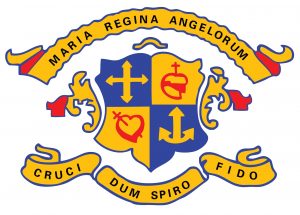History of the School
The Loreto Order

Loreto School Crest
The Institute of the Blessed Virgin Mary was founded by Mary Ward (1585-1645). It introduced a new type of religious life for women. With remarkable foresight, Mary Ward realised the apostolic influence of women in families, in public life and in the Church. She chose as her particular apostolate the education of girls. Her words “I hope in God it will be seen, that women in time to come will do much” give us a glimpse of her vision for the future. The 18th Century saw the spread and the development of the Institute on the Continent and in England. It was introduced into Ireland by Frances Teresa Ball, who, having made her Novitiate in the Bar Convent, York, returned to Dublin in 1821 to establish the First House of the Irish Branch at Rathfarnham. She called it Loreto, the name by which all later foundations made from Rathfarnham are still known.
The Development of the School Building
In 1855 when Father O’Kane, Parish Priest of Omagh, asked Mother Teresa Ball for a community, Mother Felicitas Murray was appointed Superior and travelled up by stagecoach with five sisters. A house was rented in George’s Street and a small school opened. Three years later a convent and free school were built on a site donated by a friend. A link classroom block known as the ‘Med-Way’ was later built and served the needs of the school for many years. An Assembly Hall, Science Room, Home Economics Room and Library were added in 1953.
The present Art Block (which was originally a Dormitory Wing) was built in 1960. From 1975 onwards it was used as classrooms and in 1986 it became the Art Department. The ‘Med-Way’ was replaced by the present main school block in 1968-1970. The major part of the present school building was officially opened in September 1970 and after the phasing out of the Boarding School in 1975, the conversion of the boarders’ accommodation provided further classrooms.
By 1990 further plans were underway for another extension – more classrooms and Laboratory Block, All Weather Games Pitch, Refurbishment of Art & Design, Careers and Library Accommodation, Administration Block. After the Omagh bomb in 1998, the Loreto Order wanted to make a gesture to the children of Omagh through the improvement of facilities for the disabled in the school. They negotiated with DENI part funding of the installation of an access lift to all floors of the main building. This was officially opened on the 7th November 2001 by Sister Rionach Donlon, the Provincial Head of the Loreto Order in Ireland. On the 5th April 2001 Loreto Grammar School and Drumragh parish celebrated the contribution made by the Loreto Sisters to education and the wider community. The occasion marked the closure of the Convent House in Brook Street as the Loreto Sisters moved to smaller premises on the Dublin Road in Omagh.
In 2005 the school was very proud to celebrate 150 years in education in Omagh. In 2015/16 the school celebrated 160 years in existence, influencing the wholistic development of generations of young people. In December 2015, 1 new modular suite of classrooms was opened and some classrooms in the main building were refurbished. The access route into the school was also re-designed providing a new traffic circulation area which increases safety. Funding was secured as part of the Department of Educations School Enhancement Programme.
Loreto Order change to Lay Leadership in Omagh
The first lay Principal Mr Colm O’Neill held Principalship from 1994-2000, after Sr. Anne Mc Daid retired to run Loreto House, a retreat centre in Linsfort in Co Donegal. The last teaching Loreto Sister, Sister Genevieve Mullarkey retired from the staff in June 2000. The last Loreto Sister, working in the school in the area of Office Administration, Sr. Geraldine Mc Aleer, was transferred to Dublin in August 2003.
Mr O’Neill retired in August 2000 and Mrs Gráinne T. O’Hanlon was appointed Acting Principal until her formal appointment in January 2001.
Mrs O’Hanlon held Principalship until December 2020 and, in January 2021, Mrs Susan Cullinan became the third lay Principal of the school.